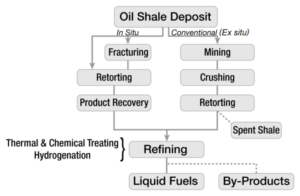 The traditional methods of oil extraction become less and less productive despite growing human needs. Today the main challenge of the oil industry is the development of a new way for oil recovering from unconventional sources. The solution is the extraction of oil or kerogen shales that allow diminishing oil prices.
The traditional methods of oil extraction become less and less productive despite growing human needs. Today the main challenge of the oil industry is the development of a new way for oil recovering from unconventional sources. The solution is the extraction of oil or kerogen shales that allow diminishing oil prices.
It is possible, because of the distributed temperature sensing (DTS) method that uses optical fiber cables, however, DTS with optical fibers using polymeric coatings becomes not efficient at temperatures exceeding 300°C, but optical fibers coated in gold withstand the temperature.
A conventional way of oil extraction includes drilling a well into a location underground, where oil flows freely from a reservoir. Also, oil can be removed using non-traditional methods. Thus, unconventional oils, for example, oil shale, are becoming more economically and technically accessible techniques thanks to absolutely new modern technologies.
Distributed temperature sensing becomes the main tool for unconventional oil recovering that makes the process more efficient with advanced methods, such as the measurement of the whole well system temperature. To be precise, it is possible for DTS to monitor the temperature at several points along the well, where optical fibers are used as the temperature sensor element.
Since the majority of DTS systems use optical fibers covered with polymeric coatings, their use is limited for temperatures up to 300 °C, because the fiber life expectancy is gradually reducing.
Such high temperatures of 350 °C are necessary for kerogen to oil conversion. So new distributed temperature sensing with optical fibers coated in gold is able to stand temperatures as high as 700 °C and identify hot spots that are highly important to regulating in-ground systems.
One of the main aims of the new DTS program is the actual well temperatures measurement. Moreover, continuously monitoring well temperatures is crucial for precisely controlling the amount and rate of heat applied because finally, this estimates the amount of oil that will be extracted at the time of the in-situ retort process.
Also distributed temperature sensor systems are used in numerous fields, for example, power cable monitoring, fire detection, leakage detection, industrial induction furnace surveillance, pipelines integrity surveillance, healthcare and biomedicine areas, etc. Nevertheless, the use of DTS systems in oil and gas production is the main factor driving the growth of the DTS market.
Optromix is a DTS system manufacturer that provides top of the line distributed temperature sensing systems suitable for monitoring the underground power cable temperature profile. If you have any questions or would like to buy a DTS system, please contact us at info@optromix.com

